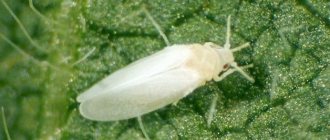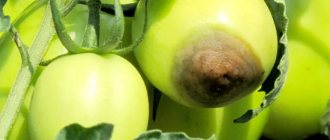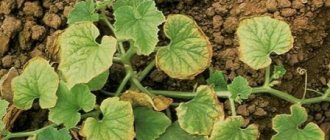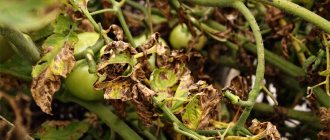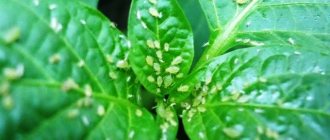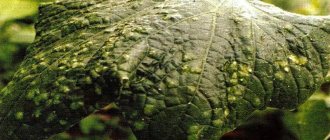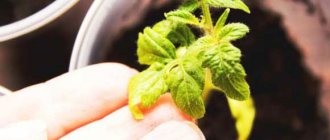How does it spread?
This disease is spread by:
- leafhoppers;
- some types of bedbugs;
- clover afrodes.
Microorganisms that cause stolbur overwinter in the rhizomes of perennial plants, such as plantain, elderberry, thistle, bindweed, St. John's wort and others. At the beginning of summer, leafhoppers and other insects begin to feed on the juices of these plants, and pathogens enter their digestive tract without causing them any harm.
In July, when insects reproduce in large numbers, they move to summer cottages to feast on already grown tomatoes, eggplants and other vegetables. Through a bite, the pathogen enters the plant cell, and after three to four weeks the first signs of the disease appear.
Reference! The incubation period for stolbur is 30 days.
Most often, this plant disease occurs in the southern regions, in the Krasnodar Territory and Rostov Region. After all, cicadas need dry, hot weather to reproduce. However, due to climate warming, these insects can survive well in more northern areas.
In what ways can stolbur spread?
Phytoplasmosis is an extremely Western disease, the spread of which occurs due to sucking insects, for example, various types of cicadas. In the winter season, mycoplasmas, which are single-celled microorganisms of the causative virus, can persist for a long time in the root systems of perennial weeds, namely milkweed, plantain, etc.
Important! Cicada larvae also usually overwinter there and, by eating the sap of diseased plants, become infected with the virus themselves. Adult insects begin to disperse in mid-summer and, accordingly, infect weeds and vegetable crops with phytoplasmosis.
The rate of development of mycoplasma and its activity changes every year, which is associated with changes in the wintering conditions of insects carrying the disease. If climate conditions do not have a favorable effect on the rate of development, reproduction and migration of vectors (for example, in the region there are very cold and little snow winters), the harmfulness of the tomato column decreases. The opposite effect is observed in areas with high air and ground temperatures.
Signs of infection: description and photo of affected tomatoes
- The leaves of infected tomatoes begin to turn yellow, curl and dry out.
- Flowers look deformed and underdeveloped.
- The petals grow together and may have a greenish or purple tint.
- The sepals take on the shape of a bell.
- Stamens and pistils develop poorly and are much smaller than those of a healthy plant.
If the infection occurs at the flowering stage, there will be no fruit, since the ovary does not form on diseased flowers. If in a later period, then you can still save 70% of the harvest by taking protective measures. The fruits are formed of irregular shape, there are no seeds in them, the pulp is permeated with white and hard fibers, hypertrophied vessels.
The root system is also affected: it becomes covered with a brown crust and cracks.
Important! In seeds, even taken from an infected fruit, phytoplasmosis does not persist.
In the photo you can see tomatoes affected by the disease.
Symptoms of the disease
The parasite penetrates into the cellular and intercellular fluids of plants, disrupting biochemical processes and causing abnormalities in tissue growth. As a result, when the disease is stolbur, the appearance of all organs of the tomato bush changes.
Signs of stolbur in tomatoes:
- Yellow spots with a pink or purple tint appear on the leaves, the edges rise along the central vein. Young leaves do not grow to the required size.
- Flowers are deformed, may have fused or reduced petals, and be uncharacteristically large in size. The petals acquire a pale tint or greenish tones in color.
- Tomato fruits take on an irregular shape, seeds are absent or contained in small quantities. The pulp is penetrated by white and hard fibrous tissue - lignified, hypertrophied vessels. Infected fruits are not edible.
- Many cracks form on the roots, their skin acquires a brown tint.
- Lignification of the internal tissues of fruits, roots and stems of tomatoes occurs.
Treatment methods
Unfortunately, tomatoes have no genetic protection against stolbur. Therefore, the fight against phytoplasmosis comes down mainly to preventive measures.
Agrotechnical methods of control
- It is preferable to choose early-ripening varieties so that they have time to ripen before the infection spreads.
- Early planting of seedlings.
- The following varieties are considered resistant to infection: Vostok, Volgogradsky.
- Tomatoes and other nightshades must be planted at a distance of 500 - 1000 meters from each other.
- Mulching the soil with straw.
- A small area can be covered with gauze sewn into one piece.
- Infected tomatoes are destroyed and burned so that the infection does not spread to other vegetable crops. The soil also needs to be replaced.
- In autumn, deep digging of the site leads to depletion of the root system of weeds and to the partial death of wintering insects.
Folk remedies
- Experienced gardeners advise planting fragrant onions or jusai onions near tomatoes. Cicadas cannot tolerate it and therefore avoid it.
- You can also spray tomatoes with the following solution to repel insects: one glass of milk and five to six drops of iodine per liter of water. The liquid takes on the smell of creamy ice cream, which the cicadas do not like. In addition, milk contains arachidic acid, which increases the resistance of tomatoes to adverse factors.
Chemicals for soil and plant treatment
Phytoplasmin
The most effective drug is Phytoplasmin. This is the only bactericidal agent that fights directly against stolbur. During the growing season, the plants themselves are sprayed and the soil is watered twice with an interval of 7-12 days. Prepare a solution at the rate of 30 ml of the drug per 30 liters of water. The cost of Phytoplasmin is 307 rubles per 100 ml.
After this, the drug Extrasol must be added to the soil, which restores the microflora, which is also destroyed after the use of Fitoplasmin.
Phytoplasmin is absolutely safe for people.
Confidor
They also use a new generation drug called Confidor, which has a contact-intestinal effect. First, a concentrated solution is prepared - 2 g of the drug per 100 ml of water, and then it is diluted with water to 1 liter. If plants are treated with this liquid, the insects die immediately after eating the tomato. The cost of Confidor is 29 rubles per package.
How does stolbur affect infected tomatoes?
The appearance of stolbur in vegetables is associated with their infection with the Lycopersicum virus 5 Smith virus, which belongs to the category of phytoplasma microorganisms. 2 types of disease have been identified:
- causes streaks to appear on fruits;
- leads to a change in foliage color to anthocyanin color.
With a large number of pathogenic microorganisms in a plant, this leads to disruption of vital processes that occur in its cells and tissues, which leads to clogging of blood vessels and the development of chloroticity.
Phytoplasmas, as a rule, begin to be located in plant cells along the cytoplasmic membranes. The stronger and more dangerous the manifestations of phytoplasmosis and its consequences for tomatoes will be, the greater the number of their cells that are filled with harmful phytoplasma microorganisms. Also, under the influence of stolbur, there is a sharp decrease in the volume of dry substances contained in the vegetable crop, which also worsens the commercial quality of the resulting fruits.
Prevention measures
- Destruction of weeds on the site.
- In early spring, before sowing garden crops, weed sprouts can be treated with Roundup.
- Plant tall plants such as corn and sunflowers around the perimeter of the property to act as a barrier to leafhoppers or other insects.
- Seedlings aged 25-30 days are sprayed with Aktara, Confidor, Moskilap.
- Before planting seedlings in the ground or in a greenhouse, the treatment is repeated.
- One week after planting in the ground or greenhouse, spray with Fufanon, Decis, Tsitkor.
- During years of heavy leafhopper reproduction or simply in dry, hot weather, plants need to be sprayed every 7-10 days.
- Before the fruits ripen, it is no longer possible to use pesticides, but you can spray the plants with Farmayod (the treatment is repeated every 7-10 days).
Experienced gardeners advise inspecting plants more often so as not to miss the moment when you can still fight the disease and save the harvest.
Signs of phytoplasmosis damage
A characteristic sign of a disease that affects tomatoes is a change in the appearance of their generative organs:
- Leaves become smaller in size. The color changes from green to yellow, pinkish with a purple tint. The edges of the leaves curl, bending upward.
- Flower petals, on the contrary, become large. Often they grow together, and the tomato flower becomes like a bell. The edges of the petals acquire a characteristic lilac tint.
- Inside the flower, the pistils and stamens remain underdeveloped and small. Pollen is not formed or is formed weakly, the tomato becomes sterile.
- The set fruits harden and are often deformed. White vascular tissue is clearly visible on the pulp of a cut tomato. Few seeds are produced in fruits affected by stolbur.
- The stems become woody, and a brown or brown core is visible when cut through the root.
Some signs of tomato stolbur are characteristic of other viral diseases (mosaic, yellow curl) and phosphorus deficiency. The presented photo of a diseased plant will help to accurately determine the disease that has affected the tomatoes.
Causes
The viral disease is spread by the sucking parasites of the leafhopper and the slobbering frog. Parasites thrive under conditions of prolonged drought. Feeding on the milky sap of the plant, they secrete a sticky substance that covers the tomato foliage. The pest's feeding on foliage does not cause any particular harm to tomatoes; it only slightly slows down their growth. However, after 3-4 days, spots of the Aspergillus fungus, which is the causative agent of stolbur, appear on the tomato foliage.
The reproductive structures of the sooty fungus completely clog the spores of the plant, normal photosynthesis stops, leading to wilting and death of the foliage. The mushroom tolerates temperature drops down to -28 degrees, so it lives in soil and plant debris for many years.
Related article: Plant verticillium, how to treat
Phytoplasma stolbur appears on the entire part of tomatoes. An infected plant can be distinguished by the following characteristics:
- as a result of the accumulation of plant glycosides, the stepsons and apical part acquire a blue-red hue;
- diseased foliage becomes smaller, becomes pale green, and curls into tubes;
- as a result of oversaturation of plant cells with starch, the vegetative mass becomes rough and brittle;
- flowers acquire a paniculate shape, become sterile, fruits are not set;
- fruits that have already set acquire a yellowish tint, become woody, and become unsuitable for food.
Conditions for the spread of the disease
Cicadas remain active for 2-3 months. The first pests emerge at the end of May. What factors influence the spread of leafhoppers:
- Temperature conditions. Optimal temperatures for insects are high. In cold winters with little snow, pests die and disease incidence decreases.
- Humidity. As humidity increases, leafhopper activity increases.
- Timing of infection. Maximum infection occurs in the first ten days of July and lasts until mid-August.
Treatment with folk remedies
Tar soap solution
An old folk remedy, using which gardeners successfully get rid of many sucking and gnawing pests.
Preparation:
- Grate a piece of birch tar soap;
- Place in a 10 liter container, fill with hot water;
- add 3 tablespoons of sugar, stir;
- Spray once every five days throughout the tomato growing season.
Tincture of garlic and tobacco
Being natural repellents, garlic and tobacco will help scare away the leafhopper from the area.
Preparation:
- prepare a 5 liter container;
- Place 200 g of chopped garlic, 100 g of tobacco or shag into a container;
- pour boiling water, set aside in a warm place for a day;
- After steeping, strain the solution, add 1 cap of dishwashing detergent;
- carry out spraying with a spray bottle from the moment the seedlings are planted in the ground once every 6-7 days.
Whey solution with iodine
If there is a sooty fungus on the foliage and stems, treating the plants with whey will help.
Preparation:
- Heat 5 liters of whey to a temperature of 40 degrees;
- add 3 tablespoons of sugar, 30 drops of iodine;
- spray the affected plants once every 2-3 days.
If tomatoes are severely infected with stolbur phytoplasma, the plants can no longer be treated, and diseased bushes should simply be burned. Therefore, it is extremely important to carry out preventive measures in a timely manner:
- spraying with repellent preparations, starting from the moment of planting seedlings;
- autumn digging of the soil with the addition of copper sulfate and wood ash;
- timely fertilizing with complex fertilizer to maintain plant immunity;
- Promptly remove weeds from the area that may contain pest larvae.
- To prevent the development of the fungus, it is necessary to organize burning of old leaves, weeds on the site, and whitewashing the bark of trees with lime. After all, it is in them that the pest – a carrier of infection – will spend the winter.
- To water tomatoes, use only tap water. In reservoirs or rainwater can be infected with phytoplasma.
- When sowing tomato seeds, you should use only soil mixture purchased in specialized stores. After all, leafhopper larvae and fungal spores may remain in the garden soil.
The tomatoes had hard, light-colored compactions inside, from the very tail and through the entire fruit - you couldn’t bite them. Only a little juice under the pulp on top, and the rest is all hard and not tasty. But from the outside the fruits look normal. What could it be?
Judging by the description, your tomatoes are affected by a disease called stolbur
, or trunk (Stolbur of tomato). The causative agent is an invisible phytoplasmic microorganism that occupies an intermediate position between bacteria and viruses. Phytoplasmas, unlike viruses, are not transmitted by seeds, do not infect another plant with sap when the cells are mechanically damaged, and do not persist in the soil, but, like many viruses, they can live for years in perennial rhizomatous, tuberous and root-producing cultivated and weed plants (thistle, bindweed, spurge, alfalfa, sow thistle, plantain, nightshade, chicory, etc.).
Features of tomato processing
The dose and frequency of spraying depends on the planting location:
- Nuances when spraying in a greenhouse. The consumption of the product is 1.5-2 times less compared to open beds, since half as many insects fly under the film. Processed in non-sunny weather.
- In open areas. The dosage and quantity are selected taking into account the severity. For irrigation, choose dry, cloudy weather.
After processing the plants, they begin to care for the soil:
- remove all weeds;
- glyphosates are spilled on the beds twice - “Tornado”, “Hurricane”;
- To destroy the cicada, they use Aktara.

